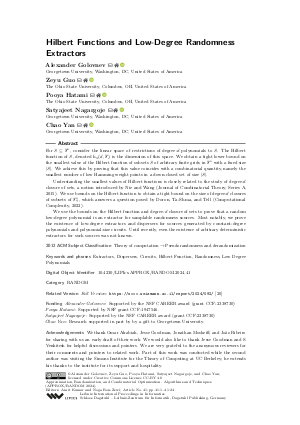LIPIcs.APPROX-RANDOM.2024.41.pdf
- Filesize: 0.86 MB
- 24 pages

 Creative Commons Attribution 4.0 International license
Creative Commons Attribution 4.0 International license

For S ⊆ 𝔽ⁿ, consider the linear space of restrictions of degree-d polynomials to S. The Hilbert function of S, denoted h_S(d,𝔽), is the dimension of this space. We obtain a tight lower bound on the smallest value of the Hilbert function of subsets S of arbitrary finite grids in 𝔽ⁿ with a fixed size |S|. We achieve this by proving that this value coincides with a combinatorial quantity, namely the smallest number of low Hamming weight points in a down-closed set of size |S|. Understanding the smallest values of Hilbert functions is closely related to the study of degree-d closure of sets, a notion introduced by Nie and Wang (Journal of Combinatorial Theory, Series A, 2015). We use bounds on the Hilbert function to obtain a tight bound on the size of degree-d closures of subsets of 𝔽_qⁿ, which answers a question posed by Doron, Ta-Shma, and Tell (Computational Complexity, 2022). We use the bounds on the Hilbert function and degree-d closure of sets to prove that a random low-degree polynomial is an extractor for samplable randomness sources. Most notably, we prove the existence of low-degree extractors and dispersers for sources generated by constant-degree polynomials and polynomial-size circuits. Until recently, even the existence of arbitrary deterministic extractors for such sources was not known.












































Feedback for Dagstuhl Publishing